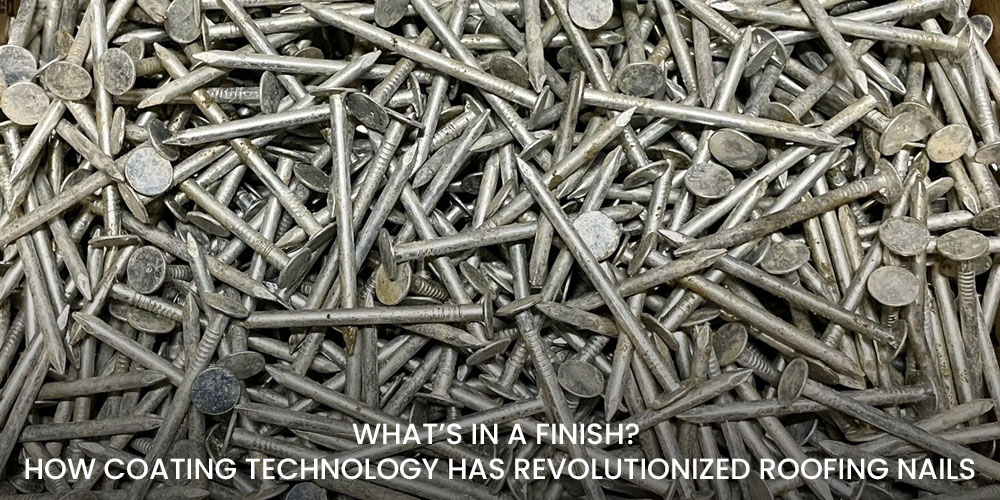
The humble roofing nail might not look like much at first glance. It’s small, seemingly straightforward, and often overlooked in the grand scheme of construction. But here’s the thing—this simple fastener has been transformed by technology. Especially in the world of roofing nail supply, one breakthrough has reshaped its role in the industry: coatings.
So, what’s in a finish? And why is it getting so much attention from manufacturers, wholesalers, and construction professionals in the USA, Canada, the UK, and Europe? Let’s dig in.
The Evolution of Roof Nails: More Than Just Metal
There was a time when roof nails were made of untreated steel. They worked, but only up to a point. In areas with moisture, fluctuating temperatures, or heavy winds, those plain nails would rust, loosen, or even snap over time. The need for more durability led to the rise of coated nails.
Today, coatings are a must-have. They don’t just look nice; they’re engineered for real-world conditions. Coatings help nails last longer, grip better, and resist the elements. That’s not a luxury; it’s smart building practice.
Why Coating Technology Matters
A coating is not just a top layer of paint. It’s a scientifically formulated barrier that can make or break the performance of a roofing nail. Here’s how coatings are changing the game:
1. Corrosion Resistance
- Moisture is roofing’s worst enemy.
- Galvanized and polymer coatings protect nails from rust and decay.
- This extends the life of the roof, especially in coastal or humid climates.
2. Better Grip, Better Hold
- Some coatings increase the friction between the nail and roofing material.
- That helps prevent shifting, lifting, or early failures.
- This is especially useful in high-wind areas or when securing heavy shingles.
3. Compatibility with Roofing Materials
- Asphalt shingles, metal sheets, and composite roofing all interact differently with fasteners.
- Certain coatings prevent chemical reactions or material breakdowns.
- That’s essential for avoiding long-term structural issues.
4. Better Storage for Bulk Supply
- Coated nails last longer in warehouses or during long shipping timelines.
- That means less product loss for wholesalers.
- No one wants to open a box and find half the nails rusted through.
Types of Roofing Nail Coatings
Each type of coating serves a different purpose. The right finish depends on where the nails will be used and what they’ll be securing.
Electro-Galvanized Coating
- A thin layer of zinc applied with an electrical current
- Good for dry or indoor areas
- Cost-effective but not ideal for outdoor roofing
Hot-Dip Galvanized (HDG)
- Dipped in molten zinc for a thick, protective layer
- Excellent for exterior use in varied climates
- The most widely used option in roofing
Stainless Steel or Polymer Coated
- Built to resist even saltwater or industrial pollution
- Best for coastal, snowy, or acidic environments
- More expensive but extremely long-lasting
Phosphate or Cement Coating
- Helps nails hold better by increasing friction
- Useful when high pull-out resistance is needed
Industry-Specific Benefits
Let’s break down how different players in the roofing ecosystem benefit from coated nails:
Contractors
- Reduced callbacks due to nail failures
- Faster installation with smooth-driving coatings
- Better compliance with local building codes
Wholesalers and Distributors
- Longer shelf life = less waste
- Reliable product quality across shipments
- Higher customer satisfaction and repeat business
Manufacturers
- Consistency in batch performance
- Easier to meet diverse client specs across regions
- Easier integration into international supply chains
The Cost vs. Benefit Debate
Yes, coated nails can cost more upfront. But consider what they save in the long run:
- Fewer replacements
- Fewer repairs
- Less chance of roofing system failure
When you’re handling large-volume construction projects, those savings add up fast. Choosing the right coating isn’t about spending more; it’s about getting more value.
How Coating Helps During Installation
It’s not just about long-term performance; coated nails also make the installation process smoother:
- Easy Drive: Coated nails go in more cleanly, reducing strain on tools and arms.
- Fewer Jams: Especially true with polymer-coated nails used in automated guns.
- Better Bonding: Some coatings even help nails adhere better to felt or insulation layers.
Roof Nails and Regulatory Compliance
Modern building codes are strict, especially in North America and Europe. Uncoated or low-grade fasteners can lead to failed inspections.
- Coated roofing nails meet wind, corrosion, and load-bearing standards.
- Many coastal areas require HDG or polymer-coated fasteners by law.
- Using coated nails helps contractors avoid legal and warranty issues.
Global Demand and Roofing Nails Export
In today’s market, consistency and performance are everything. For those involved in roofing nails export, coating technology ensures:
- Longer shelf life in shipping containers
- Performance in varied climates from Arizona to Scotland
- Less rust-related product rejection from international clients
This quality assurance strengthens brand reputation globally.
Real-World Applications of Coated Roofing Nails
Let’s look at some practical scenarios where coating makes a difference:
- Cold climates: In snowy regions, HDG nails prevent ice-related corrosion.
- Tropical environments: Polymer-coated nails withstand constant humidity.
- Industrial zones: Stainless steel nails resist pollutants in the air.
- Mountain towns: Nails with phosphate coatings hold stronger in wooden decking.
The finish you choose isn’t just a technical detail—it’s critical to performance and safety.
Why Crystal Fasteners Leads the Way
At Crystal Fasteners, we take coating seriously because we know it impacts everything else:
- We offer HDG, polymer-coated, stainless steel, and phosphate-coated options.
- Our products undergo strict quality testing for durability, friction, and corrosion resistance.
- As part of our roofing nails supply, we ensure timely delivery, consistent quality, and expert guidance.
Whether you’re sourcing for a single project or scaling for wholesale, our team ensures your nails perform under pressure.
Final Thoughts
The finish on a roofing nail isn’t an afterthought—it’s a frontline defence against the elements, friction, and time. Coating technology has redefined what a roofing nail can do, both during installation and throughout its lifespan.
For those who build with integrity, the small things matter. That’s why fasteners and their finishes should never be overlooked.
Want to build better, stronger, and longer-lasting roofs? Start with nails that deliver more. Start with Crystal Fasteners.
